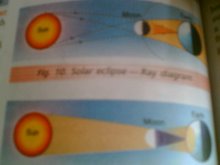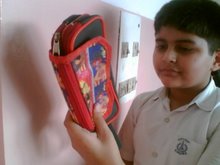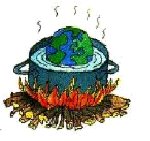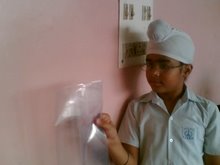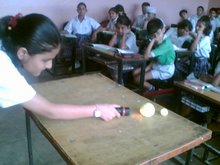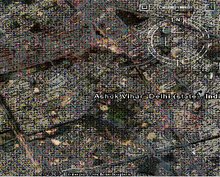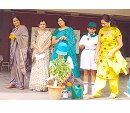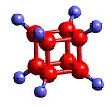Saturday, 2 June 2007
OUR BONUS
changing teaching trends
and keep updating them always!
Student involvement and motivation
is our BONUS!
We wish to see our students be the best of the rest.
Friday, 1 June 2007
What is this element's chemical symbol?
Match the following chemical symbols to their corresponding elements:";stw+="";for (i=0; i ";stw+="" + e_s[s_l[i]] + "is the symbol for";stw+="";for (j=0; j " + e_n[n_l[j]];}stw+="";}stw+="";document.writeln(stw);
// -->
Match the following chemical symbols to their corresponding elements:
Ho
is the symbol for
Top of Form
MolybdenumCesiumEuropiumBerkeliumCobaltTechnetiumHolmiumSodiumLutetiumGoldLawrenciumUnunhexiumRadiumAstatineDarmstadtium
Bottom of Form
Eu
is the symbol for
Top of Form
MolybdenumCesiumEuropiumBerkeliumCobaltTechnetiumHolmiumSodiumLutetiumGoldLawrenciumUnunhexiumRadiumAstatineDarmstadtium
Bottom of Form
Ra
is the symbol for
Top of Form
MolybdenumCesiumEuropiumBerkeliumCobaltTechnetiumHolmiumSodiumLutetiumGoldLawrenciumUnunhexiumRadiumAstatineDarmstadtium
Bottom of Form
Mo
is the symbol for
Top of Form
MolybdenumCesiumEuropiumBerkeliumCobaltTechnetiumHolmiumSodiumLutetiumGoldLawrenciumUnunhexiumRadiumAstatineDarmstadtium
Bottom of Form
Bk
is the symbol for
Top of Form
MolybdenumCesiumEuropiumBerkeliumCobaltTechnetiumHolmiumSodiumLutetiumGoldLawrenciumUnunhexiumRadiumAstatineDarmstadtium
Bottom of Form
Tc
is the symbol for
Top of Form
MolybdenumCesiumEuropiumBerkeliumCobaltTechnetiumHolmiumSodiumLutetiumGoldLawrenciumUnunhexiumRadiumAstatineDarmstadtium
Bottom of Form
Lu
is the symbol for
Top of Form
MolybdenumCesiumEuropiumBerkeliumCobaltTechnetiumHolmiumSodiumLutetiumGoldLawrenciumUnunhexiumRadiumAstatineDarmstadtium
Bottom of Form
Cs
is the symbol for
Top of Form
MolybdenumCesiumEuropiumBerkeliumCobaltTechnetiumHolmiumSodiumLutetiumGoldLawrenciumUnunhexiumRadiumAstatineDarmstadtium
Bottom of Form
Lr
is the symbol for
Top of Form
MolybdenumCesiumEuropiumBerkeliumCobaltTechnetiumHolmiumSodiumLutetiumGoldLawrenciumUnunhexiumRadiumAstatineDarmstadtium
Bottom of Form
At
is the symbol for
Top of Form
MolybdenumCesiumEuropiumBerkeliumCobaltTechnetiumHolmiumSodiumLutetiumGoldLawrenciumUnunhexiumRadiumAstatineDarmstadtium
Bottom of Form
atom
We can try this simple activity to explain the structure of atoms to the students.
We will be using cotton balls, pipe cleaners and beads to model atoms. It is important that everyone use the same color cotton balls for neutrons and another color for protons so that we can compare our models. Likewise, it is important that we all use the same color pipe cleaners and beads. So, before getting our materials, the class must agree on what colors to use. Record the colors here:
____________ color of cotton balls for neutrons
____________ color of cotton balls for protons
____________ color of beads for electrons
____________ color of pipe cleaners for electron shells
____________ color of pipe cleaner for supporting the model
MATERIALS & EQUIPMENT
1 periodic table
__ cotton balls for protons
__ cotton balls for neutrons
__ beads for electrons
__ pipe cleaners for electron shells
1 pipe cleaner to support the model
2 index cards
tacky glue
LAB SAFETY
_________________________________________________________________________
_________________________________________________________________________
_________________________________________________________________________
PROCEDURE
Select your favorite element from the periodic table. Write down the following information:
Element Name:
Element Symbol:
Number of protons:
Number of neutrons:
Number of electrons:
Number of shells:
Figure out what materials you will need and write the quantities in the list on the first page:
For each neutron, you will need one cotton ball of the appropriate color.
For each proton, you will need one cotton ball of the appropriate color.
You will need one bead for each electron.
You will need two pipe cleaners for the first electron shell and three for the second electron shell.
Get your materials.
Glue the protons and neutrons (cotton balls) to one end of the support pipe cleaner to make the nucleus (see Figure 1). Once the nucleus is complete, set it aside to dry.
Figure 1
In the mean time, twist together the ends of the two pipe cleaners for the first electron shell. String on the appropriate number of beads to represent electrons (no more than two).
Form the pipe cleaners into a circle to make the electrons' orbit. Twist the remaining ends together to close the circle but leave about 1" of each end sticking out (see Figure 2).
Figure 2
Repeat this for the second electron shell (if appropriate for your element) only use three pipe cleaners twisted together and a maximum of eight electrons.
Place the first shell around the nucleus and twist the ends of the pipe cleaners around the support pipe cleaner to hold the shell in place (see Figure 3).
Repeat this for the second shell if appropriate.
Figure 3
Write the name and symbol for your element on each of the index cards and glue (or staple) the cards back-to-back near the top of the support pipe cleaner.
QUESTIONS
In what ways is your model unlike a real atom?
_________________________________________________________________________
_________________________________________________________________________
_________________________________________________________________________
In what ways is your model like a real atom?
_________________________________________________________________________
_________________________________________________________________________
_________________________________________________________________________
Ideas for Motivating Students
I take this oppertunity to highlight a few
Ideas for Motivating Students.
They are as under:
Explain
Teachers should spend more time explaining why we teach what we do, and why the topic or approach or activity is important and interesting and worthwhile. In the process, some of the teacher's enthusiasm will be transmitted to the students, who will be more likely to become interested.
Reward
Rather than criticizing unwanted behavior or answers, reward correct behavior and answers. Remember that adults and children alike continue or repeat behavior that is rewarded. The rewards can (and should) be small and configured to the level of the students. Small children can be given a balloon, a piece of gum, or a set of crayons, books, lunches, certificates, verbal praise, and so on for good performance. Even something as apparently "childish" as a "Good Job!" stamp or sticker can encourage students to perform at higher levels.
Care
Students respond with interest and motivation to teachers who appear to be human and caring. Teachers can help produce these feelings by sharing parts of themselves with students, especially little stories of problems and mistakes they made, either as children or even recently. Such personalizing of the student/teacher relationship helps students see teachers as approachable human beings and not as aloof authority figures.
Have students participate
One of the major keys to motivation is the active involvement of students in their own learning. Standing in front of them and lecturing to them (at them?) is thus a relatively poor method of teaching. It is better to get students involved in activities, group problem solving exercises, helping to decide what to do and the best way to do it, helping the teacher, working with each other, or in some other way getting physically involved in the lesson. A lesson about nature, for example, would be more effective walking outdoors than looking at pictures.
Teach Inductively
It has been said that presenting conclusions first and then providing examples robs students of the joy of discovery. Why not present some examples first and ask students to make sense of them, to generalize about them, to draw the conclusions themselves?
Satisfy students' needs
Attending to need satisfaction is a primary method of keeping students interested and happy. Students' basic needs have been identified as survival, love, power, fun, and freedom.
Make learning visual
we can provide better learning by attaching images to the ideas we want to convey. Use drawings, diagrams, pictures, charts, graphs, bulleted lists, even three-dimensional objects you can bring to class to help students anchor the idea to an image. It is very helpful to begin a class session or a series of classes with a conceptual diagram of the relationship of all the components in the class so that at a glance students can apprehend a context for all the learning they will be doing. This will enable them to develop a mental framework or filing system that will help them to learn better and remember more.
Use positive emotions to enhance learning and motivation
Strong and lasting memory is connected with the emotional state and experience of the learner. That is, people remember better when the learning is accompanied by strong emotions. If you can make something fun, exciting, happy, loving, or perhaps even a bit frightening, students will learn more readily and the learning will last much longer.
Remember that energy sells
Being energetic in your teaching is a motivating factor in itself; adding energy to the ideas you want to convey will further enhance learning and commitment to the ideas.
Savita Dhutti
Ideas for Motivating Students.
I take this oppertunity to highlight a few
Ideas for Motivating Students.
They are as under:
Explain
Teachers should spend more time explaining why we teach what we do, and why the topic or approach or activity is important and interesting and worthwhile. In the process, some of the teacher's enthusiasm will be transmitted to the students, who will be more likely to become interested.
Reward
Rather than criticizing unwanted behavior or answers, reward correct behavior and answers. Remember that adults and children alike continue or repeat behavior that is rewarded. The rewards can (and should) be small and configured to the level of the students. Small children can be given a balloon, a piece of gum, or a set of crayons, books, lunches, certificates, verbal praise, and so on for good performance. Even something as apparently "childish" as a "Good Job!" stamp or sticker can encourage students to perform at higher levels.
Care
Students respond with interest and motivation to teachers who appear to be human and caring. Teachers can help produce these feelings by sharing parts of themselves with students, especially little stories of problems and mistakes they made, either as children or even recently. Such personalizing of the student/teacher relationship helps students see teachers as approachable human beings and not as aloof authority figures.
Have students participate
One of the major keys to motivation is the active involvement of students in their own learning. Standing in front of them and lecturing to them (at them?) is thus a relatively poor method of teaching. It is better to get students involved in activities, group problem solving exercises, helping to decide what to do and the best way to do it, helping the teacher, working with each other, or in some other way getting physically involved in the lesson. A lesson about nature, for example, would be more effective walking outdoors than looking at pictures.
Teach Inductively
It has been said that presenting conclusions first and then providing examples robs students of the joy of discovery. Why not present some examples first and ask students to make sense of them, to generalize about them, to draw the conclusions themselves?
Satisfy students' needs
Attending to need satisfaction is a primary method of keeping students interested and happy. Students' basic needs have been identified as survival, love, power, fun, and freedom.
Make learning visual
we can provide better learning by attaching images to the ideas we want to convey. Use drawings, diagrams, pictures, charts, graphs, bulleted lists, even three-dimensional objects you can bring to class to help students anchor the idea to an image. It is very helpful to begin a class session or a series of classes with a conceptual diagram of the relationship of all the components in the class so that at a glance students can apprehend a context for all the learning they will be doing. This will enable them to develop a mental framework or filing system that will help them to learn better and remember more.
Use positive emotions to enhance learning and motivation
Strong and lasting memory is connected with the emotional state and experience of the learner. That is, people remember better when the learning is accompanied by strong emotions. If you can make something fun, exciting, happy, loving, or perhaps even a bit frightening, students will learn more readily and the learning will last much longer.
Remember that energy sells
Being energetic in your teaching is a motivating factor in itself; adding energy to the ideas you want to convey will further enhance learning and commitment to the ideas.
Savita Dhutti
Ideas for Motivating Students
I take this oppertunity to highlight a few
Ideas for Motivating Students.
They are as under:
Explain
Teachers should spend more time explaining why we teach what we do, and why the topic or approach or activity is important and interesting and worthwhile. In the process, some of the teacher's enthusiasm will be transmitted to the students, who will be more likely to become interested.
Reward
Rather than criticizing unwanted behavior or answers, reward correct behavior and answers. Remember that adults and children alike continue or repeat behavior that is rewarded. The rewards can (and should) be small and configured to the level of the students. Small children can be given a balloon, a piece of gum, or a set of crayons, books, lunches, certificates, verbal praise, and so on for good performance. Even something as apparently "childish" as a "Good Job!" stamp or sticker can encourage students to perform at higher levels.
Care
Students respond with interest and motivation to teachers who appear to be human and caring. Teachers can help produce these feelings by sharing parts of themselves with students, especially little stories of problems and mistakes they made, either as children or even recently. Such personalizing of the student/teacher relationship helps students see teachers as approachable human beings and not as aloof authority figures.
Have students participate
One of the major keys to motivation is the active involvement of students in their own learning. Standing in front of them and lecturing to them (at them?) is thus a relatively poor method of teaching. It is better to get students involved in activities, group problem solving exercises, helping to decide what to do and the best way to do it, helping the teacher, working with each other, or in some other way getting physically involved in the lesson. A lesson about nature, for example, would be more effective walking outdoors than looking at pictures.
Teach Inductively
It has been said that presenting conclusions first and then providing examples robs students of the joy of discovery. Why not present some examples first and ask students to make sense of them, to generalize about them, to draw the conclusions themselves?
Satisfy students' needs
Attending to need satisfaction is a primary method of keeping students interested and happy. Students' basic needs have been identified as survival, love, power, fun, and freedom.
Make learning visual
we can provide better learning by attaching images to the ideas we want to convey. Use drawings, diagrams, pictures, charts, graphs, bulleted lists, even three-dimensional objects you can bring to class to help students anchor the idea to an image. It is very helpful to begin a class session or a series of classes with a conceptual diagram of the relationship of all the components in the class so that at a glance students can apprehend a context for all the learning they will be doing. This will enable them to develop a mental framework or filing system that will help them to learn better and remember more.
Use positive emotions to enhance learning and motivation
Strong and lasting memory is connected with the emotional state and experience of the learner. That is, people remember better when the learning is accompanied by strong emotions. If you can make something fun, exciting, happy, loving, or perhaps even a bit frightening, students will learn more readily and the learning will last much longer.
Remember that energy sells
Being energetic in your teaching is a motivating factor in itself; adding energy to the ideas you want to convey will further enhance learning and commitment to the ideas.
Savita Dhutti
rainbow creating activity
Dear friends
We can try this rainbow creating activity with the students of classes 6-8.
An experiment to see if rainbow will form on the wall when the light is shined into the water.
PROBLEM:
How can I make a spectrum (rainbow)?RESEARCH: Look up visible light, spectrum, or rainbows in a science textbook or encyclopedia. Write two or three paragraphs on what you learned.HYPOTHESIS: What do you think you need to do to make a rainbow?
MATERIALS:
flashlight
shallow bowl of water
pocket mirror
protractor
PROCEDURE:
1. Use the protractor to set the mirror in the bowl at 30 degrees from the bottom of the bowl. Use clay or wax to hold the mirror in place.
2. Darken the room (or do the project at night).
3. Shine the flashlight toward the mirror.
4. Describe what you see.
5. Enrichment: On a very sunny day, spray the hose in an arc. Move around the spray until you see a rainbow in the spray. Based on what you have learned, explain why a rainbow forms in the spray.
DATA:
Make a data table to record your observations.
CONCLUSION:
Explain what you learned by doing this activity.
Savita Dhutti
Build Your Own Volcano
I want to share an activity I undertook with my students.
Build Your Own Volcano
Materials
Baking pan or cover of a large bucket
Soda bottle (16 ounce or 20 ounce)
Moist soil or sand
1 tablespoon baking soda
1 cup vinegar
Red food coloring
Procedure
Color the vinegar with red food coloring.
Put the baking pan (or cover) on the ground and place the soda bottle in the middle of it.
Shape the moist soil (or sand) around the bottle to form a mountain. Bring the soil to the bottle's opening, but don't get the soil inside the bottle.
Pour the baking soda into the bottle.
Pour the colored vinegar into the bottle
Watch red foam spray out of the top and down the mountain like lava from a volcano.
Why it happened
The baking soda reacted with the vinegar to produce carbon dioxide gas. The gas built up enough pressure to push the foaming liquid out of the top of the bottle.
I tried this activity with class VI students and they enjoyed it very much.
Savita Dhutti















